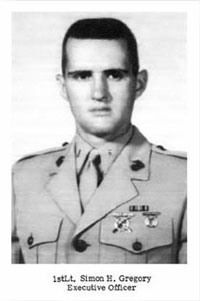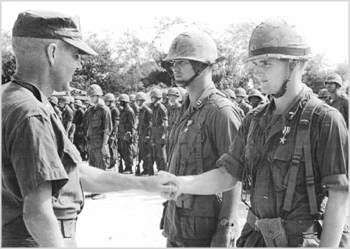In Command — 1st Lt. Simon Gregory & the Battle for Hill 50
UPDATE (Feb. 4, 2017): Simon Gregory, who is the subject of this web page, has published portfolio of photographs documenting his tour of duty in South Vietnam during the Vietnam War, as well as the preceding months when he married and began training with the 3rd Battalion, 1st Marines. The Vietnam War was a life-defining series of events, some of which — the very worst — revisit its veterans every day for the rest of their lives. But the war also consisted of “little moments” that are too easily forgotten. Photographs like Simon’s help us to recall how the war widened our world view, brought new friends into our lives, and sometimes even made us smile. To see Simon’s photographs, go to Vietnam 1965-1966.
For 35 years following my tour of duty in Vietnam, I had little contact with other veterans, and none at all with members of my unit, 3rd Battalion, 1st Marines. In the 1990s, the growing efficiency of the Internet coincided with and fostered my own growing need to learn more about my own role and that of the Marines in the war. I began a tentative quest and eventually was able to contact Simon Gregory by email.
1st. Lt. Simon Gregory

1st. Lt. Simon Gregory commanded Lima Company, 3/1 — my company — at the time of Operation Utah, in early March, 1966. Previously, he had been Lima Company’s executive officer, but just before Operation Utah he was temporarily promoted to company commander when Capt. James T. Sehulster was hospitalized temporarily because of burns to his eyes, a result of walking through a cloud of white phosphorous smoke.
Although Simon remembers me, which seems to be typical of the man, I don’t remember Simon: I had been transferred from Headquarters & Service Company into Lima Company only 13 days before Operation Utah, and spent most of my time with my 3rd Platoon squad. Lima Company was the third Marine Corps company I had served with since I had joined 3/1
There was this, too: In the month since we had landed in Vietnam, I had witnessed a dozen incidents involving sudden death, severe wounds, and the torture of prisoners by Marines and South Vietnamese “Popular Force” militiamen. I had begun to armour myself emotionally against such incidents: although I could not have articulated it at the time, I now realize that I was probably incapable of making friends with marines who might be dead or maimed in the next moment. I was already suffering symptoms of combat-related Post-Traumatic Stress Disorder, although it would not be diagnosed for more than 40 years.
Even now, almost five decades later, I cannot easily reach out to people, and I am far more comfortable with casual relationships than close ones. It was not easy for me to contact with Simon, but I am glad that I did. This seems to be a common experience for Vietnam combat veterans, most of whom in my experience are loners, like me. Nevertheless, my contact with Simon helped me to take important steps towards understanding my role in the Vietnam War, and particularly in Operation Utah and the Battle for Hill 50. Here is what Simon wrote in his first email:
Email from Simon
Dear Bob,
Thanks for your message. I fully understand how you feel about initiating contact with those of us that share our common experience. My involvement has been only with Lt. Walsh,1 Lt. Cleaver and Lt. Crowley.2 Both Walsh and Cleaver were wounded the same day you were. I lost 10 men and had 20 more wounded (you included). The North Vietnamese suffered 33 official dead in combat with our company, but I believe there were more that were not counted due to the massive carnage. Frankly, I did not worry about body counts and only provided cursory info to Battalion.
During the battle I captured an NVA soldier after jumping in to a shell crater with him. We were both surprised, but I had the advantage as I later discovered that he was wounded. It was a very definitive moment as I first believed that I would have to kill him, but since I had him by the front of his shirt with my left hand, I was unable to pull my pistol and cock it. This meant that all I had left was my combat knife. Although I drew the knife, it could see in his eyes that he had surrendered. I carried him down the hill to the improvised aid station the Corpsmen had set up for treating the wounded. Unfortunately, he died later that day. The NVA soldiers we engaged that day fought to the last man.
Your account of the battle indicated that we were ambushed.3 True enough, but this happened mainly because the ARVN Ranger unit on the top of the hill got word to us that they had secured the objective.... The so-called “secured” objective was actually occupied by a well dug in NVA Company. The very moment that the ARVN indicated contact with us was when we took our first assault from the NVA. My reaction was to give orders to return fire…. [Simon believes it is possible that the first casualties Lima Company inflicted were upon ARVN troops who were standing on top of the hill, with the NVA soldiers between us and them. Although ARVN units were in the immediate area, he does not recall seeing or hearing from them for the duration of the battle, nor do I.]
…After the initial bursts of fire that morning, it was all that I could do to maintain a cohesive presence on the battlefield. The wounded were on need of attention, the dead had to be removed, the enemy had to be dealt with as I determined that there was no way to disengage without taking more casualties. The urge to flee affected some of us initially I am sure, but it soon became obvious that we all knew the course of action required and stood our ground. I had one deserter that day, which was a difficult situation to deal with on top of everything else. My own mental state had put me past the fear stage quite early on and I essentially was comfortable with the fact that I could die at any moment. A calmness came over me that allowed me to function with effectiveness. Some have described it as an “out of body experience”. Needless to say the emotions, sights, sounds and smells of that battle still remain with me and rarely a day goes by that I don’t recall the experience.
It was not all bad by any means, but it is surely a hard way to get an education. My tour ended in late August of ’66. However, my wife and I returned a couple of years ago on our own two-person tour. I have to say it was a wonderful experience. We visited Hanoi, Hue and Da Nang, where I was stationed with the Battalion from April through August ’66. Our area of responsibility ran from just south of the airstrip down to Hoi An. The Marble Mountain complex was included and it was there that I had a lot of contact with the civilian population. In addition to being the Battalion S-2 [Intelligence officer], I was also responsible for civil affairs. This offered me another view of the war that many did not get….
Kindest personal regards,
Simon
Poignant words
Simon wrote later to explain that he had spent a lot of time over the years second-guessing his actions at the very beginning of Lima Company’s engagement with the communists on Hill 50. His poignant words should be required reading for every officer candidate in every army:
I still wish I could do Utah over again. Maybe you would not have been wounded along with the 18 others, maybe the 10 dead would be alive. If only I had done things differently. Should I have questioned the info received from the ARVN unit? Sent scouts out in advance of our moving to the hill? Waited with two platoons on line and effected reconnaissance by fire? Withdrawn a few hundred yards and asked for more mortars, artillery, naval gunfire, close air support? Tried a flanking movement? Unfortunately, I had about 60 seconds to process all of the choices and in fact had no time at all. As Caesar said when he crossed the Rubicon, “Alea jacta est,” The die has been cast. Also, flight crossed my mind as well, but my makeup eliminated it as an option. We were just little teeth on the gears that had been turning since the 1850’s when the French dropped anchor in Danang harbor.
Simon Gregory, 1st Lt. (Retired)
Simon receives the Silver Star medal

A sign of Simon’s professionalism is that he has continued to revisit his command decisions since that long-ago day of battle. However, I am confident that none of the marines or corpsman who were under his command, not to mention his superiors, would ever have questioned those decisions.
The Marine Corps certainly didn’t: not long after the battle, in a ceremony at Da Nang, Lt. Col. James R. Young, 3/1 commander, presented Simon with the Silver Star Medal in recognitions of his actions. A Stars and Stripes newspaper article quoted the award citation: “Disregarding his own safety in the withering fire, Lt. Gregory moved among his platoons skillfully controlling their movement and encouraging his men to pursue the attack.” Characteristically, Simon has explained that he accepted the Silver Star on behalf of the 10 marines of Lima Company who died on Hill 50.